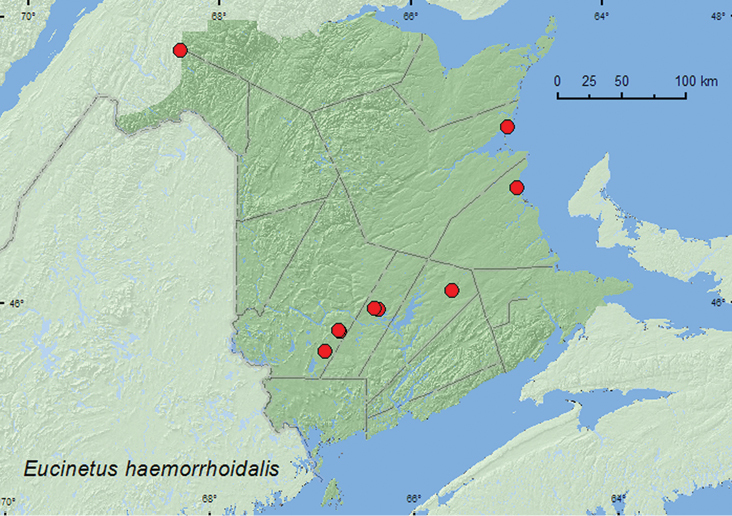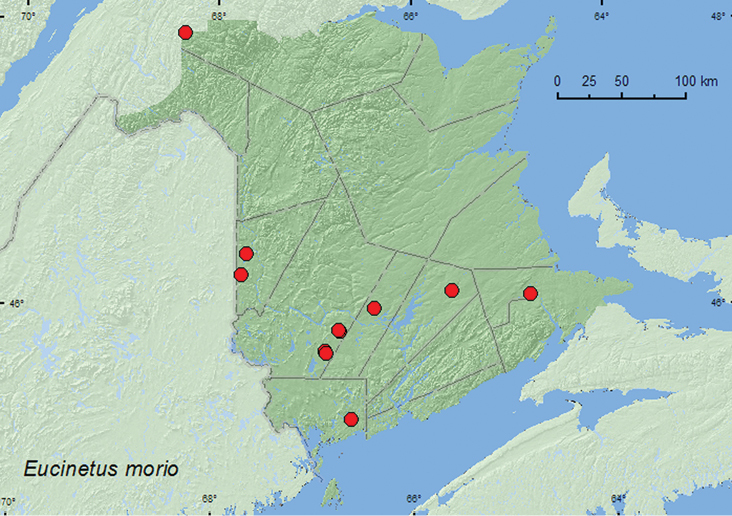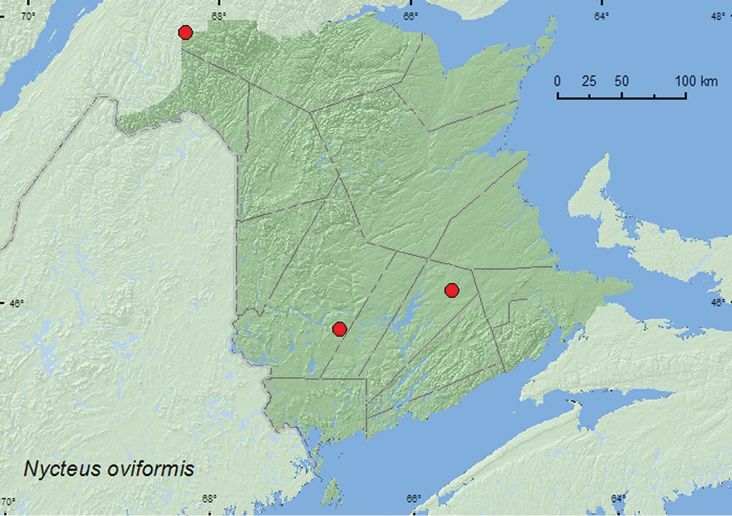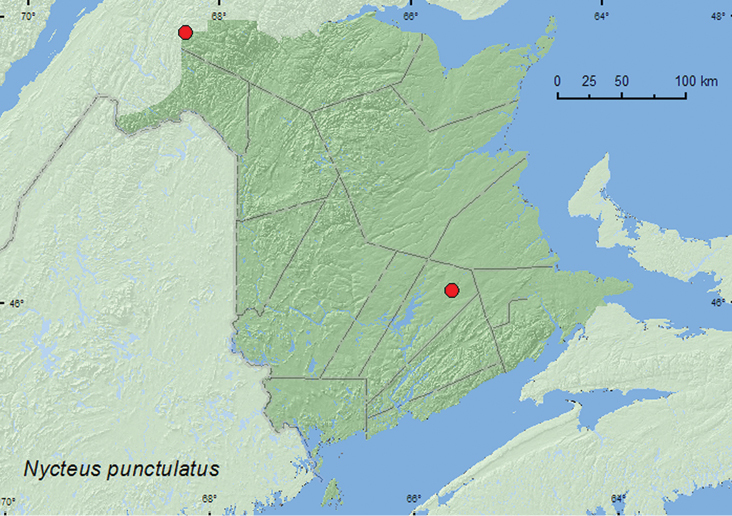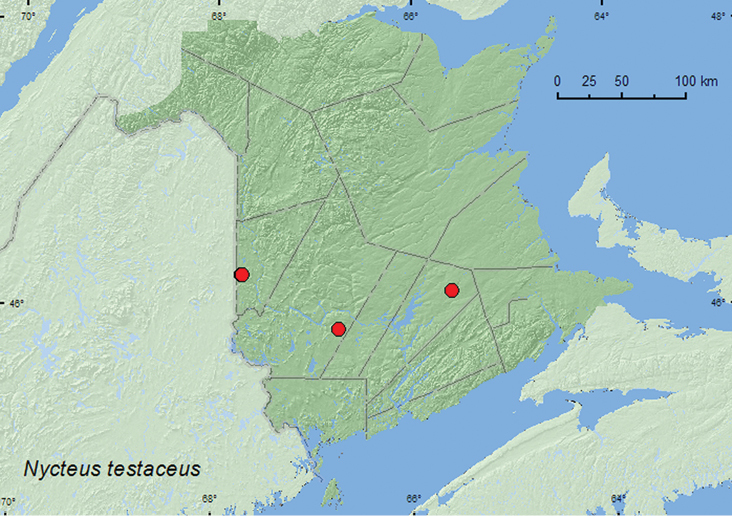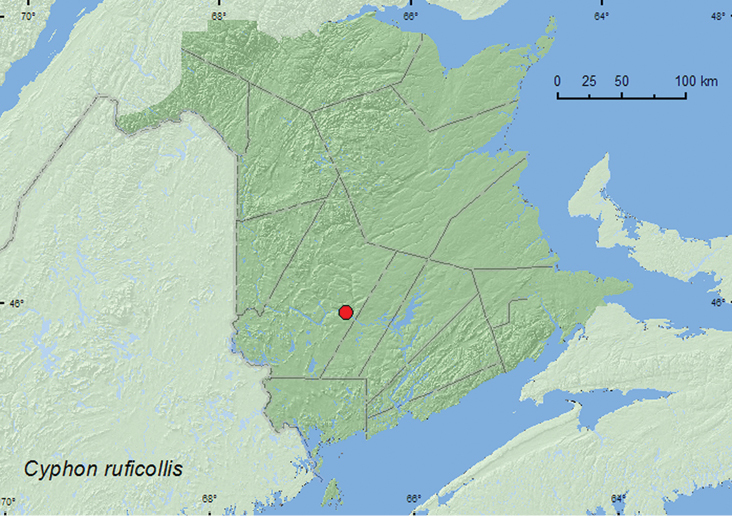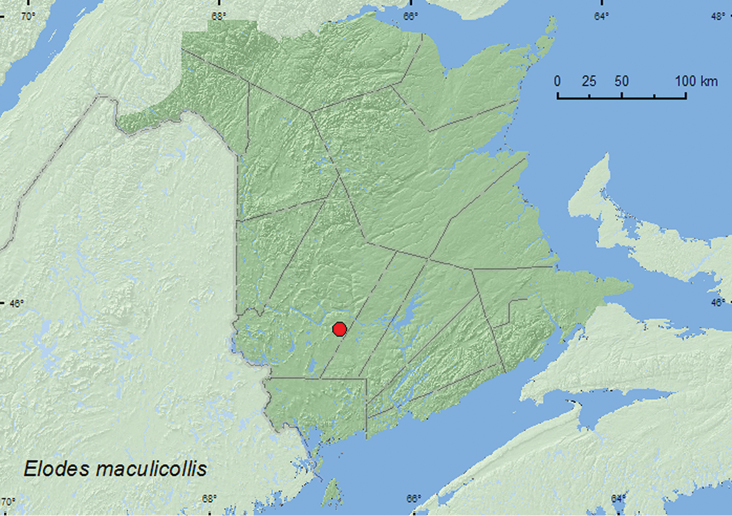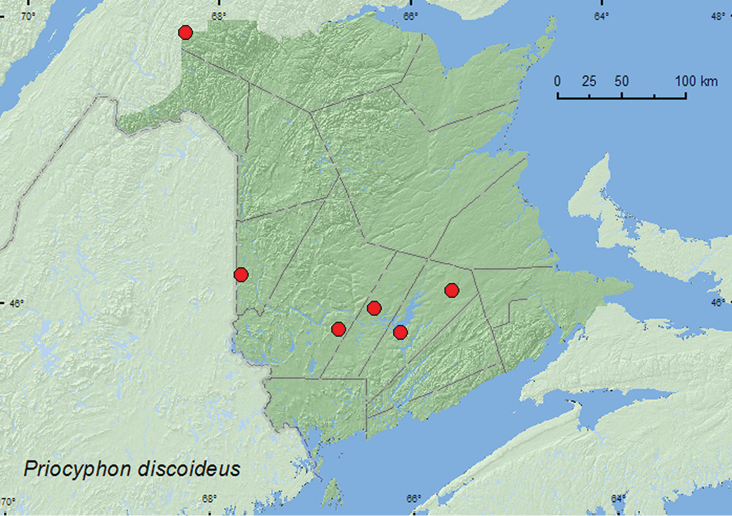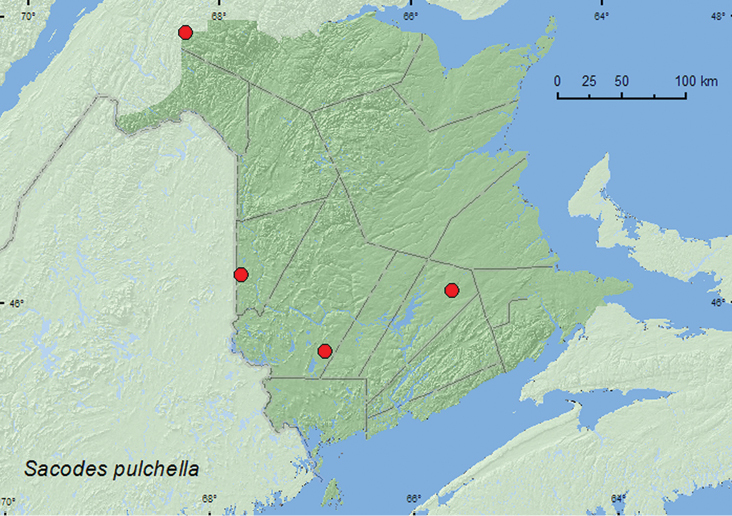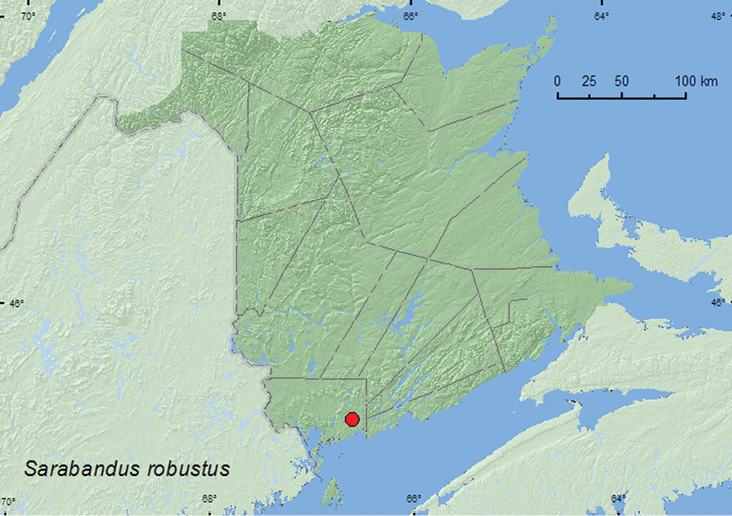






(C) 2012 Reginald P. Webster. This is an open access article distributed under the terms of the Creative Commons Attribution License 3.0 (CC-BY), which permits unrestricted use, distribution, and reproduction in any medium, provided the original author and source are credited.
For reference, use of the paginated PDF or printed version of this article is recommended.
We report two species of Eucinetidae, Nycteus oviformis (LeConte) and Nycteus punctulatus (LeConte), new to New Brunswick, Canada and confirm the presence of Nycteus testaceus (LeConte). Nycteus oviformis is newly recorded from the Maritime provinces. Additional locality data are provided for Eucinetus haemorrhoidalis (Germar) and Eucinetus morio LeConte. Five species of Scirtidae, Cyphon ruficollis (Say), Prionocyphon discoideus (Say), Sacodes pulchella (Guérin-Méneville), Elodes maculicollis Horn, and Sarabandus robustus (LeConte) are added to the New Brunswick faunal list. Sarabandus robustus is newly recorded from Canada; Cyphon ruficollis, Prionocyphon discoideus and Sacodes pulchella are new for the Maritime provinces. Collection and habitat data, and distribution maps are presented for these species.
Eucinetidae, Scirtidae, Scirtoidea, Canada, New Brunswick, new records
This paper treats new records from New Brunswick of two related families of beetles, the Eucinetidae and Scirtidae. The Eucinetidae of the Maritime provinces (New Brunswick, Nova Scotia, Prince Edward Island) of Canada was recently treated by
The following records are based on specimens collected during a general survey by the first author to document the Coleoptera fauna of New Brunswick and from by-catch samples obtained in trapping experiments testing attractants for surveying Cerambycidae. Additional provincial records were obtained from specimens contained in the collection belonging to Natural Resources Canada, Canadian Forest Service - Atlantic Forestry Centre, Fredericton, New Brunswick.
Collection methodsVarious methods were employed to collect the species reported in this study. Details are outlined in
Keys in
Distribution maps, created using ArcMap and ArcGIS, are presented for each species in New Brunswick. Every species is cited with current distribution in Canada and Alaska, using abbreviations for the state, provinces, and territories. New records for New Brunswick are indicated in bold under Distribution in Canada and Alaska. The following abbreviations are used in the text:
| AK | Alaska | MB | Manitoba |
| YT | Yukon Territory | ON | Ontario |
| NT | Northwest Territories | QC | Quebec |
| NU | Nunavut | NB | New Brunswick |
| BC | British Columbia | PE | Prince Edward Island |
| AB | Alberta | NS | Nova Scotia |
| SK | Saskatchewan | NF & LB | Newfoundland and Labrador* |
*Newfoundland and Labrador are each treated separately under the current Distribution in Canada and Alaska.
Acronyms of collections examined or where specimens referred to in this study reside are as follows:
AFC Atlantic Forestry Centre, Natural Resources Canada, Canadian Forest Service, Fredericton, New Brunswick, Canada
CNC Canadian National Collection of Insects, Arachnids and Nematodes, Agriculture and Agri-Food Canada, Ottawa, Ontario, Canada
NBM New Brunswick Museum, Saint John, New Brunswick, Canada
RWC Reginald P. Webster Collection, Charters Settlement, New Brunswick, Canada
Results Species accountsAll records below are species newly recorded for New Brunswick, Canada unless noted otherwise (additional records). Species followed by ** are newly recorded from the Maritime provinces of Canada; species followed by *** are newly recorded from Canada.
The classification of the Eucinetidae follows
The Eucinetidae (the plate-thigh beetles) have greatly expanded metathoracic coxal plates that conceal much of the first abdominal segment and the metathoracic legs. Adults live in various kinds of litter or under fungus-covered bark (
Additional New Brunswick records. Madawaska Co., Loon Lake, 236 m elev., 47.7839°N, 68.3943°W, 21.VII.2010, R. P. Webster, boreal forest, small lake surrounded by sedges, treading sedges and grasses near Myrica gale bushes into water (1, NBM). Queens Co., Cranberry Lake P.N.A. (Protected Natural Area), 46.1125°N, 65.6075°W, 12–21.V.2009, 21–27.V.2009, 5–11.VI.2009, R. Webster & M.-A. Giguère, old red oak forest, Lindgren funnel trap (1, RWC). Sunbury Co., Acadia Research Forest, 45.9816°N, 66.3374°W, 12.V.2007, R. P. Webster, 8.5 year-old regenerating mixed forest, sifting moss and litter (2, RWC); same locality but 45.9866°N, 66.3841°W, 19–25.V.2009, R. Webster & M.-A. Giguère, red spruce forest with red maple and balsam fir, Lindgren funnel traps (2, RWC). York Co., 15 km W of Tracy off Rt. 645, 45.6848°N, 66.8821°W, 19–25.V.2009, 1–8.VI.2009, R. Webster & M.-A. Giguère, old red pine forest, Lindgren funnel traps (2, AFC, RWC); Charters Settlement, 45.8267°N, 66.7343°W, 30.IV.2005, R. P. Webster, Carex marsh, in sphagnum in Carex hummock (2, RWC); same locality and collector but 45.8331°N, 66.7410°W, 14.IV.2006, mixed forest, in litter and sphagnum (1, RWC).
Collection localities in New Brunswick, Canada of Eucinetus haemorrhoidalis.
This species was collected along a lake margin, and in a Carex marsh, an old red oak (Quercus rubra L.) forest, a mature red spruce (Picea rubens Sarg.) forest, an old red pine (Pinus resinosa Ait.) forest, a mature mixed forest, and an 8.5-year-old regenerating mixed forest. Adults were collected by treading sedges (Carex sp.) and grasses along a lake margin, sifting moss and leaf litter, and sifting sphagnum from a Carex hummock in a Carex marsh. This species was capable of jumping out of a 15 cm high sifting box. This species was also captured in Lindgren funnel traps. Adults were collected during April, May, June, and July.
NT, BC, AB, SK, MB, ON, QC, NB, NS, PE (
Additional New Brunswick records. Carleton Co., Two Mile Brook Fen, 46.3619°N, 67.6733°W, 6.V.2005, R. Webster & M.-A. Giguère, cedar forest/swamp, in moist sphagnum (1, RWC); Jackson Falls, Bell Forest, 46.2200°N, 67.7231°W, 8.VIII.2006, R. P. Webster, mature hardwood forest, on polypore fungi on dead standing beech (1, NBM); same locality and forest type but 4–12.VI.2008, 27.VI–5.VII.2008, 12–19.VII.2008, R. P. Webster, mature hardwood forest, Lindgren funnel traps (5, AFC, RWC) ); same locality and habitat data but 28.IV-9.V.2009, 9–14.V.2009, 14–20.V.2009, 20–26.V.2009, 31.VII–7.VIII.2009, R. Webster & M.-A. Giguère, Lindgren funnel traps (7, AFC, RWC). Charlotte Co., 10 km NW of New River Beach, 45.2110°N, 66.6170°W, 31.V–15.VI.2010, 16–26.VII.2010, R. Webster & C. MacKay, old growth eastern white cedar forest, Lindgren funnel traps (2, AFC). Queens Co., Cranberry Lake P.N.A., 46.1125°N, 65.6075°W, 12–21.V.2009, 21–27.V.2009, 5–11.VI.2009, 28.VII-6.VIII.2009, R. Webster & M.-A. Giguère, old red oak forest, Lindgren funnel traps (4, AFC, RWC). Restigouche Co., Dionne Brook P.N.A., 47.9064°N, 68.3441°W, 31.V-15.VI.2011, M. Roy & V. Webster, old-growth white spruce and balsam fir forest, Lindgren funnel trap (1, NBM). Sunbury Co., Acadia Research Forest, 45.9866°N, 66.3841°W, 19–25.V.2009, 2–9.VI.2009, 16–24.VI.2009, 24–30.VI.2009, 29.VII-4.VIII.2009, R. Webster & M.-A. Giguère, red spruce forest with red maple and balsam fir, Lindgren funnel traps (8, AFC). York Co., Charters Settlement, 45.8286°N, 66.7365°W, 10.VII.2005, R. P. Webster, mature red spruce and cedar forest, in powdery slime mould (1, NBM); same locality but 45.8331°N, 66.7410°W, 17.VIII.2008, R. P. Webster, mature red spruce forest, in polypore fungi on dead standing Populus sp. (1, RWC); 15 km W of Tracy off Rt. 645, 45.6848°N, 66.8821°W, 1–8.VI.2009, 28.VI-7.VII.2009, 29.VII-4.VIII.2009, R. Webster & M.-A. Giguère, old red pine forest, Lindgren funnel traps (6, AFC); 14 km WSW of Tracy, S of Rt. 645, 45.6741°N, 66.8661°W, 10–26.V.2010, 16–30.VI.2010, R. Webster & C. MacKay, old mixed forest with red and white spruce, red and white pine, balsam fir, eastern white cedar, red maple, and Populus sp., Lindgren funnel traps (2, AFC).
Collection localities in New Brunswick, Canada of Eucinetus morio.
Eucinetus morio was found in a variety of forest types in New Brunswick, including mature hardwood forests, an old red oak forest, old and mature mixed forests, an old-growth white spruce (Picea glauca (Moench) Voss) and balsam fir (Abies balsamea (L.) Mill.) forest, eastern white cedar (Thuja occidentalis L.) forests, a mature (110-year-old) red spruce forest, and an old red pine forest. Most specimens were captured in Lindgren funnel traps deployed in the above forest types. Specimens with specific habitat data were collected from moist sphagnum (in eastern white cedar swamp), on polypore fungi on dead standing American beech (Fagus grandifolia Ehrh.) and a dead standing Populus sp., and in powdery slime mold at the base of a tree.
ON, QC, NB, NS (
New Brunswick, Queens Co., Cranberry Lake P.N.A, 46.1125°N, 65.6075°W, 18–31.VIII.2011, M. Roy & V. Webster, old red oak forest, Lindgren funnel trap (1, RWC). Restigouche, Co., Dionne Brook P.N.A., 47.9064°N, 68.3441°W, 27.VI-14.VII.2011, 14–28.VII.2011, M. Roy & V. Webster, old-growth white spruce and balsam fir forest, Lindgren funnel traps (2, RWC). York Co., Charters Settlement, 45.8430°N, 66.7275°W, 30.VI.2008, R. P. Webster, regenerating mixed forest, brushy opening, sweeping foliage (1, RWC).
Collection localities in New Brunswick, Canada of Nycteus oviformis.
Adults were captured in Lindgren funnel traps deployed in an old red oak forest and an old-growth white spruce and balsam fir forest. One individual was swept from foliage in a brushy opening of a regenerating (15-year-old) mixed forest. Adults were captured during June, July, and August.
MB, NB (
New Brunswick, Queens Co., Cranberry Lake P.N.A, 46.1125°N, 65.6075°W, 18–25.VI.2009, 25.VI-1.VII.2009, 1–10.VII.2009, 28.VII–6.VIII.2009, R. Webster & M.-A. Giguère, old red oak forest, Lindgren funnel traps (5, RWC); same locality data and forest type, 7–13.VII.2011, 18–31.VIII.2011, M. Roy & V. Webster, Lindgren funnel traps (2, NBM, RWC). Restigouche Co., Dionne Brook P.N.A., 47.9030°N, 68.3503°W, 14–28.VII.2011, 28.VII-9.VIII.2011, 9–23.VIII.2011, M. Roy & V. Webster, old-growth northern hardwood forest, Lindgren funnel traps (7, AFC, NBM, RWC); same locality and collectors but 47.9064°N, 68.3441°W, 27.VI-14.VII.2011, 9–23.VIII.2011, old-growth white spruce and balsam fir forest, Lindgren funnel traps (7, AFC, NBM, RWC).
Collection localities in New Brunswick, Canada of Nycteus punctulatus.
The New Brunswick adults were captured in Lindgren funnel traps deployed in an old red oak stand, an old-growth northern hardwood forest with sugar maple (Acer saccharum Marsh.) and yellow birch (Betula alleghaniensis Britt.), and in an old-growth white spruce and balsam fir forest. Adults were collected during June, July, and August.
YK, BC, AB, SK, MB, ON, QC, NB, NS (
Additional New Brunswick records, Carleton Co., Jackson Falls, Bell Forest, 46.2199°N, 67.7232°W, 13.VIII.2007, R. P. Webster, hardwood forest, on gilled mushrooms (4, RWC); same locality but 46.2210°N, 67.7210°W, 25.VII.2007, R. P. Webster, hardwood forest, u.v. light (1, RWC). Queens Co., Cranberry Lake P.N.A, 46.1125°N, 65.6075°W, 25.VI–1.VII.2009, R. Webster & M.-A. Giguère, old red oak forest, Lindgren funnel trap (1, RWC). York Co., Charters Settlement, 45.8395°N, 66.7391°W, 23.VII.2007, 7.IX.2007, R. P. Webster, mixed forest, u.v. light (2, RWC).
Collection localities in New Brunswick, Canada of Nycteus testaceus.
Nycteus testaceus was collected from gilled mushrooms on the forest floor of a hardwood forest, and at an ultraviolet light in a mixed forest and a hardwood forest. One individual was captured in a Lindgren funnel trap deployed in an old red oak forest. This species was capable of jumping out of a 15 cm high sifting box, resulting in the loss of a number of specimens collected from gilled mushrooms. Adults were captured during July, August, and September.
NT, BC, AB, SK, MB, ON, QC, NB (
The Scirtidae (the marsh beetles), as their common name implies, are associated with marshes and other kinds of wetlands (
Species of Eucinetidae and Scirtidae recorded from New Brunswick, Canada.
| Family Eucinetidae Lacordaire |
| Eucinetus haemorrhoidalis (Germar) |
| Eucinetus morio LeConte |
| Nycteus oviformis (LeConte)** |
| Nycteus punctulatus (LeConte)* |
| Nycteus testaceus (LeConte) |
| Family Scirtidae Fleming |
| Subfamily Scirtinae Fleming |
| Cyphon collaris (Guérin-Méneville) |
| Cyphon neovariabilis Klausnitzer |
| Cyphon obscurus (Guérin-Méneville) |
| Cyphon ruficollis (Say)** |
| Cyphon variabilis (Thunberg) |
| Elodes maculicollis Horn* |
| Microcara explanata LeConte |
| Prionocyphon discoideus (Say)** |
| Prionocyphon limbatus LeConte |
| Sacodes pulchella (Guérin-Méneville)** |
| Sarabandus robustus (LeConte)*** |
| Scirtes tibialis Guérin-Méneville |
Notes: *New to province, **New to Maritime provinces, ***New to Canada
New Brunswick, York Co., Fredericton, Odell Park, 45.9570°N, 66.6695°W, 19.VI.2005, R. P. Webster, mixed forest margin, beating foliage (1, RWC).
Collection localities in New Brunswick, Canada of Cyphon ruficollis.
One individual was collected from foliage along a mixed forest margin during June.
ON, QC, NB (
New Brunswick, York Co., Charters Settlement, 45.8456°N, 66.7267°W, 16.V.2011, R. P. Webster, beaver dam among sticks and grass litter near overflow area of dam (near flowing water) (4, RWC).
Collection localities in New Brunswick, Canada of Elodes maculicollis.
Adults were collected during May inside a beaver (Castor canadensis Kuhl) dam near an overflow area in the dam.
QC, NB, NS, NF (
New Brunswick, Carleton Co., Jackson Falls, Bell Forest, 46.2200°N, 67.7231°W, 8–16.VI.2009, R. Webster & M.-A. Giguère, mature hardwood forest, Lindgren funnel trap (1, AFC, RWC). Restigouche, Co., Dionne Brook P.N.A., 47.9064°N, 68.3441°W, 14–28.VIII.2011, M. Roy & V. Webster, old-growth white spruce and balsam fir forest, Lindgren funnel trap (1, NBM). Queens Co., Cranberry Lake P.N.A, 46.1125°N, 65.6075°W, 11–18.VI.2009, 18–25.VI.2009, 25.VI-1.VII.2009, R. Webster & M.-A. Giguère, old red oak forest, Lindgren funnel traps (5, AFC, RWC); Grand Lake Meadows P.N.A., 45.8227°N, 66.1209°W, 19–31.V.2010, 15–29.VI.2010, R. Webster & C. MacKay, old silver maple forest with green ash and seasonally flooded marsh, Lindgren funnel traps (2, AFC, RWC). Sunbury Co., Acadia Research Forest, 45.9866°N, 66.3841°W, 24–30.VI.2009, R. Webster & M.-A. Giguère, red spruce forest with red maple and balsam fir, Lindgren funnel trap (1, AFC). York Co., Charters Settlement, 45.8395°N, 66.7391°W, 28.VI.2005, R. P. Webster, mixed forest, u.v. light (1, RWC).
Collection localities in New Brunswick, Canada of Prionocyphon discoideus.
Prionocyphon discoideus was captured in Lindgren funnel traps deployed in a variety of deciduous and coniferous forest types in New Brunswick. These included mature mixed forests, an old red oak forest, an old silver maple forest near a seasonally flooded marsh, a red spruce forest and an old-growth white spruce and balsam fir forest. One individual was collected at an ultraviolet light. Adults were captured during May, June, July, and August.
ON, QC, NB (
New Brunswick, Carleton Co., Bell Forest, 46.2200°N, 67.7231°W, 21–28.VI.2009, 19–31.VII.2009, R. Webster & M.-A. Giguère, mature hardwood forest, Lindgren funnel traps (2, AFC, RWC). Queens Co., Cranberry Lake P.N.A, 46.1125°N, 65.6075°W, 25.VI–1.VII.2009, 1–10.VII.2009, 15–21.VII.2009, 21–28.VII.2009, R. Webster & M.-A. Giguère, old red oak forest, Lindgren funnel traps (6, AFC, RWC); same locality data and forest type, 13–20.VII.2011, M. Roy & V. Webster, Lindgren funnel trap (1, NBM). Restigouche Co., Dionne Brook P.N.A., 47.9030°N, 68.3503°W, 27.VI-14.VII.2011, M. Roy & V. Webster, old-growth northern hardwood forest, Lindgren funnel trap (2, RWC). York Co., 15 km W of Tracy off Rt. 645, 45.6848°N, 66.8821°W, 16–30.VI.2010, R. Webster & C. MacKay, old red pine forest, Lindgren funnel trap (1, RWC).
Collection localities in New Brunswick, Canada of Sacodes pulchella.
This species was captured in Lindgren funnel traps deployed in a mature hardwood forest with sugar maple, American beech, and white ash (Fraxinus americana L.), an old red oak forest, an old-growth northern hardwood forest with sugar maple and yellow birch, and an old red pine forest. Adults were captured during June and July.
ON, NB (
Canada, New Brunswick, Charlotte Co., near New River, 45.2143°N, 66.6001°W, 2, VI.2006, R. P. Webster, eastern white cedar swamp, in moss and leaf litter (1, RWC).
Collection localities in New Brunswick, Canada of Sarabandus robustus.
The sole New Brunswick specimen was sifted from moss and leaf litter in an eastern white cedar swamp during early June.
(new Canadian record). This species is known from Massachusetts south to Florida (
We thank Caroline Simpson (AFC) for editing this manuscript. Matthew Gimmel is thanked for many helpful comments that greatly improved this manuscript. Serge Laplante (Agriculture and Agri-Food Canada (CNC), Ottawa) is thanked for determining specimens and other invaluable assistance, and Nichole Brawn, Katie Burgess, Marie-Andrée Giguère, Nancy Harn, Cory Hughes, Colin MacKay, Wayne MacKay, Jessica Price, Michelle Roy, and Vincent Webster for technical assistance and collecting specimens. Natural Resources Canada, Canadian Forest Service; the Canadian Food Inspection Agency; and the USDA APHIS are thanked for funding the study on early detection of invasive cerambycids, which provided many specimens collected in Lindgren funnel traps. We thank the New Brunswick Environmental Trust Fund and New Brunswick Wildlife Trust Fund for funding various insect surveys over the past 7 years and the Meduxnekeag River Association for permission to sample beetles at the Meduxnekeag Valley Nature Preserve (which includes the Bell Forest). The New Brunswick Department of Natural Resources (Fish and Wildlife Branch) is thanked for issuing permits for sampling in the Protected Natural Areas and for providing logistical support.
